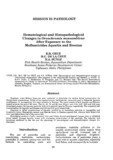Hematological and histopathological changes in Oreochromis mossambicus after exposure to the molluscicides Aquatic and Brestan
- Global styles
- MLA
- Vancouver
- Elsevier - Harvard
- APA
- Help
Share
Abstract
Duplicate static 96-hour bioassays were conducted to determine the median lethal concentration for Oreochromis mossambicus (LC50) of two organostannous molluscicides, commonly used in fishponds: Aquatin and Brestan. O. mossambicus was more sensitive to Brestan. The acute toxicity of both Aquatin and Brestan ceased towards the end of 96 hours. The 24, 48, 72 and 96 hour LC50’s were 4.01, 3.97, 2.95 and 2.58 ppm formulated product for Aquatin and 0.35, 0.18, 0.10 and 0.09 ppm for Brestan, respectively. The computed safe concentrations for Aquatin and Brestan are 0.30 and 0.01 ppm, respectively.
Exposure to lethal concentrations of Aquatin resulted in an immediate reduction in hemoglobin and hematocrit levels. Hemoglobin content was likewise lower in Brestan-exposed fish, whereas their hematocrit level was higher than that of the control fish.
Histological analyses of gills, intestine, liver and kidney showed pathological changes even in sublethal levels tested. Damage became severe with increasing concentration of the pesticide. The behavior and symptoms exhibited by the fish and the physiology of hematological and histopathological changes are discussed.
Suggested Citation
Cruz, E. R., de la Cruz, M. C., & Suñaz, N. A. (1988). Hematological and histopathological changes in Oreochromis mossambicus after exposure to the molluscicides Aquatic and Brestan. In R. S. V. Pullin, T. Bhukaswan, K. Tonguthai, & J. L. Maclean (Eds.), The Second International Symposium on Tilapia in Aquaculture, 16-20 March 1987, Bangkok, Thailand (pp. 99-110). Bangkok, Thailand: Department of Fisheries; Manila, Philippines: International Center for Living Aquatic Resources Management.
Type
Conference paperKoleksi
- Conference Proceedings [299]


